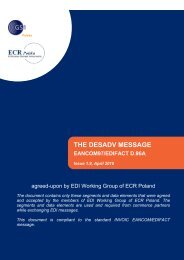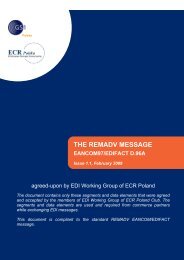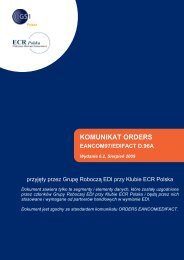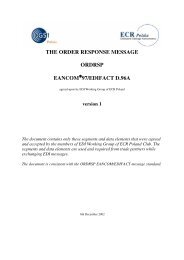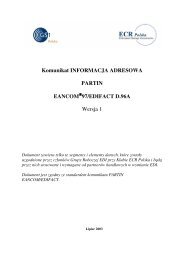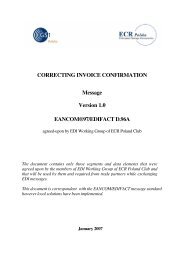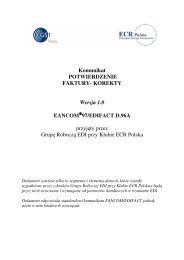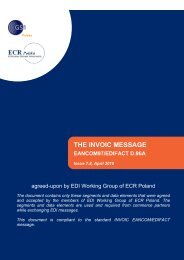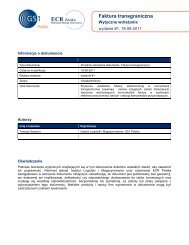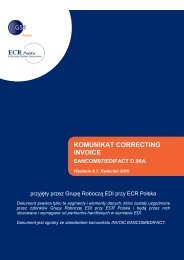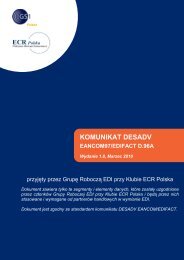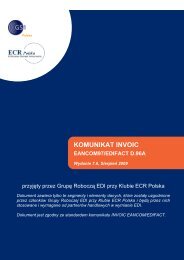MESSAGE
the correcting invoice message eancom97/edifact d.96a - ECR Polska
the correcting invoice message eancom97/edifact d.96a - ECR Polska
- No tags were found...
You also want an ePaper? Increase the reach of your titles
YUMPU automatically turns print PDFs into web optimized ePapers that Google loves.
THE CORRECTING INVOICE <strong>MESSAGE</strong> EANCOM97/EDIFACT D.96A<br />
Notes:<br />
1. The segments are presented in the sequence in which they appear in the message. The segment or<br />
segment group tag is followed by the (M)andatory / (C)onditional indicator, the maximum number of<br />
occurrences and the segment description.<br />
2. Reading from left to right, in column one, the data element tags and descriptions are shown, followed by in<br />
the second column the EDIFACT status (M or C), the field format, and the picture of the data elements.<br />
These first pieces of information constitute the original EDIFACT segment layout.<br />
Following the EDIFACT information, EANCOM specific information is provided in the third, fourth, and fifth<br />
columns. In the third column a status indicator for the use of (C)onditional EDIFACT data elements (see 2.1<br />
through 2.3 below), in the fourth column the restricted indicator (see point 3 on the following page), and in<br />
the fifth column notes and code values used for specific data elements in the message.<br />
2.1 (M)andatory data elements in EDIFACT segments retain their status in EANCOM.<br />
2.2 Additionally, there are five types of status for data elements with a (C)onditional EDIFACT status, whether<br />
for simple, component or composite data elements. These are listed below and can be identified when<br />
relevant by the following abbreviations:<br />
– REQUIRED R Indicates that the entity is required and must be sent.<br />
– ADVISED A Indicates that the entity is advised or recommended.<br />
– DEPENDENT D Indicates that the entity must be sent in certain conditions, as<br />
defined by the relevant explanatory note.<br />
– OPTIONAL O Indicates that the entity is optional and may be sent at the<br />
discretion of the user.<br />
– NOT USED N Indicates that the entity is not used and should be omitted.<br />
2.3 If a composite is flagged as N, NOT USED, all data elements within that composite will have blank status<br />
indicators assigned to them.<br />
3. Status indicators detailed in the fourth column which directly relate to the code values detailed in the first<br />
column may have two values;<br />
– RESTRICTED * A data element marked with an asterix (*) in the fourth column is (are)<br />
the only codes available for use with this data element, in this segment,<br />
in this message.<br />
– OPEN All data elements where coded representation of data is possible and a<br />
restricted set of code values is not indicated are open (no asterix in<br />
fourth column). The available codes are listed in the EANCOM Data<br />
Elements and Code Sets Directory. Code values given in tables have<br />
been agreed by the EDI Working Group. The use of other values<br />
should be bilaterally agreed.<br />
03.2013, Issue 7.3 All contents copyright © GS1 Polska | ECR Polska Page 11 of 121



